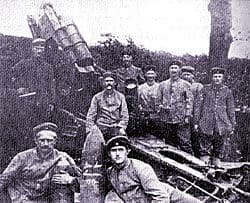
German artillery at the battle of the Somme, 1916
Neil Faulkner Archive | ETOL Main Page
From Socialist Worker, Issue 2102, 20 May 2008
Copied with thanks from the Socialist Worker Website.
Marked up by Einde O’Callaghan for the Encyclopaedia of Trotskyism On-Line (ETOL).
Our series ends with Neil Faulkner looking at the potential to abolish war for good

German artillery at the battle of the Somme, 1916 |
At the beginning of the First World War, lines of French infantry in blue coats and red trousers charged machine guns and modern artillery. The French lost one man in four in a month.
Three years later, the face of war had changed forever. Battles lasted for months. They extended across dozens of square miles. The landscape became a brown wasteland of rubble, tree stumps, shell-holes, barbed wire, and dead bodies.
Usually no one could be seen. The soldiers lived in underground complexes of trenches and tunnels. When attacking, they crept forwards in small groups using all available cover.
Casualties were still horrendous. Over a million men were killed in the 1916 Battle of the Somme. The British gained a few miles. It made no difference to the outcome of the war.
Capitalism had plunged humanity into an abyss of carnage, destruction, and waste. Industrial society’s capacity to satisfy human need through mass production had been turned into its opposite – industrialised slaughter.
Mass conscription created armies of millions. The Prussian army at Waterloo in 1815 was 60,000 men. On the Western Front in 1914 the Germans fielded 1.5 million.
Mass production provided the guns and munitions to keep such huge masses fighting.
The British had 156 artillery pieces at Waterloo in 1815. They fired a few thousand rounds in total. At the Somme in 1916 they had 1,400 artillery pieces. They fired nearly two million shells in a few days.
A technological arms race took off as scientists and engineers devised new killing machines.
In 1914, there were tens of thousands of cavalry. By 1918, there were thousands of tanks.
The result was a war of stalemate and attrition. Industrial output was decisive – the demand was always for more guns, more shells, more explosive. Millions of workers were mobilised in war industries. The “home front” became a target of bombing and blockade.
The trenches of the First World War have become symbolic of the slaughter. But they did not cause it – in fact, they provided protection from the “storm of steel” on battlefields dominated by firepower.
The cause of the slaughter was twofold.
First, the great powers were divided by imperial rivalry as their industries grew and competed. Second, when the powers clashed, these same industries could mass produce the means of destruction.
That is one reason why the Second World War was longer and bloodier than the First. It lasted six years and killed 60 million compared with four years and ten million. Global industrial capacity was that much greater 20 years later. It is highly likely that a world war today would be the worst in history.
Societies are torn apart by the slaughter and privation inherent in modern industrialised war.
To maintain support for war, the propaganda of the ruling class demonises “the enemy” and vilifies “traitors” and “spies”. Sometimes this spills over into genocidal racism.
The Ottoman Turks murdered 1.5 million Armenians in an internal “war on terror” in 1915.
A generation later, even genocide had been industrialised – the Nazis murdered six million Jews and up to six million other “sub-humans”.
The danger for the ruling class is that soldiers and workers will revolt against a murderous war of attrition. Instead of continuing a bosses’ war for empire and profit, they might put class interests before national hatreds, and make common cause with soldiers and workers in “enemy” states.
The First World War was ended by just such a revolt from below. A wave of protest and revolution swept across Europe from 1917 onwards. First Russia withdrew from the war, shutting down the Eastern Front. Then Germany, ending the war on the Western Front.
Thereafter, for several years, the revolution threatened to go global. Popular revulsion against war almost brought down the ruling classes everywhere. Capitalism survived by a whisker.
There have been many revolts against war since.
The Vietnam War was ended by the combination of Vietnamese guerrilla resistance and the anti-war movement in the rest of the world. The US empire and its British supporters face similar defeat in Iraq today.
The lessons are clear. Industrialised imperialism deploys more powerful means of destruction than ever before. Mass protest can sometimes stop the war machines. But only revolution to overthrow capitalism altogether can end war forever and create a world at peace.
Neil Faulkner Archive | ETOL Main Page
Last updated on: 10 February 2022